Side Menu:
The J.P. Morgan Federal Reserve Theory
The Proposed Theory
The American central bank, the Federal Reserve, was created on December 23, 1913, with the enactment of the Federal Reserve Act. The fact that it was a year after the sinking of the Titanic has led to allegations of conspiracy.
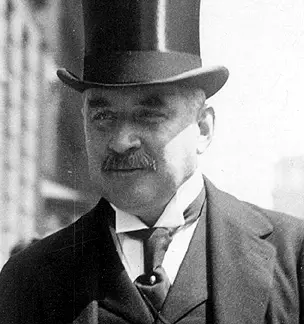
John Pierpont Morgan Sr. (April 17, 1837 – March
31, 1913) was an American financier and banker.
(Image: biography.com)
The Federal Reserve, considered to be one of the most important financial institutions in the world, is indeed connected to Titanic. The White Star Line had been owned since 1902 by the International Mercantile Marine Company, a trust formed in the early twentieth century as an attempt by J.P. Morgan to monopolize the shipping trade. So ultimately, J.P. Morgan was the owner of Titanic by the fact he held a significant ownership share of White Star Line.
It was also J.P. Morgan who forced the United States government into acting on a central banking plan during the Bank Panic of 1907 when Wall Street turned to J.P. Morgan for help. According to Investopedia.com "Morgan was able to convene all the principal players at his mansion and command all their capital to flood the system, thus floating the banks that, in turn, helped to float the businesses until the panic passed. The fact that the government owed its economic survival to a private banker forced the necessary legislation to create a central bank and the Federal Reserve." (Investopedia article)
Notably, has been claimed (erroneously) that J.P. Morgan was set to board RMS Titanic for her maiden voyage but cancelled his trip at the last minute along with his good friend Milton Hersey who also cancelled his voyage.
The maiden voyage of Titanic indeed had three of the wealthiest Americans living at the time: John Jacob Astor IV, Benjamin Guggenheim, and Isidor Straus (most conspiracy theorists mispell his name "Strauss" which gives a clue as to their level of accuracy). According to the theory, as J.P. Morgan was planning to form The Federal Reserve, he killed off any potential threats by ensuring rival millionaires Jacob Astor, Isidor Straus and Benjamin Guggenheim, who all allegedly opposed the forming of a central bank, perished aboard Titanic.
This theory got a surge of support when the pro-Trump online conspiracy-theory group QAnon mentioned it in Nov. 2017. However it is not new. According to The Washington Post, "compared to other Titanic blarney, the J.P. Morgan theory is relatively new, but QAnon didn’t invent it — it’s been echoing inside Internet rabbit holes for years." ("Fact-checking QAnon conspiracy theories: Did J.P. Morgan sink the Titanic?" August 4, 2018 by Erick Trickey Link to article)
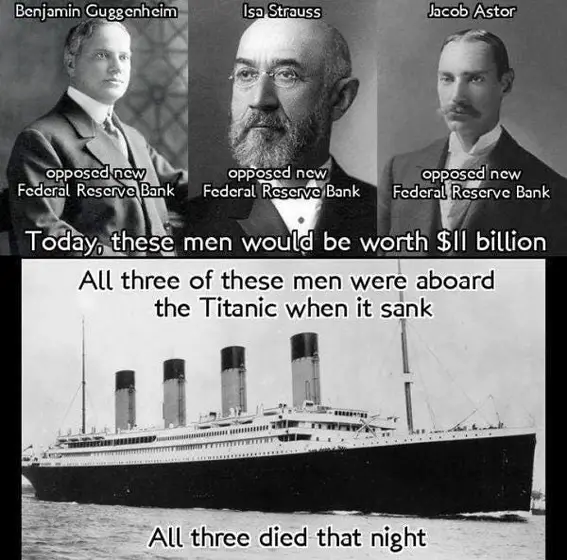
This is the "meme" often used by proponents of the Federal Reserve conspiracy theory, which alleges that millionaires Jacob Astor, Isidor ("Isa") Straus and Benjamin Guggenheim all opposed the Federal Reserve.
There are other versions of this theory including a claim that the Rothschild banking family or the Catholic order of Jesuits were the ones who arranged Astor, Straus and Guggenheim’s deaths on the Titanic. As The Washington Post notes, invoking the Rothchilds as international conspirators is “a centuries-old anti-Semitic trope… The Rothschild family founded banking houses across Europe in the early 1800s, and they have been a favorite target of conspiracy theorists ever since.” ("Fact-checking QAnon conspiracy theories: Did J.P. Morgan sink the Titanic?" August 4, 2018 by Erick Trickey Link to article)
As for the Jesuits, "as international lenders, the Rothschilds would have rather not had a US Federal Reserve, as it would stabilize the US currency and reduce their opportunities for profit from US deals." (Link to Skeptoid article)
Key Issues:
1. No documented evidence to support theory
The most critical issue with this theory is that is entirely speculation. Despite the huge amount of time, money and people involved, there has not been one documented item of evidence or eyewitness testimony to support the claim.
Moreover, key elements of the theory are inaccurate, as the next three points reveal:
2. Straus supported Federal Reserve; Astor and Guggenheim not opposed
There is very little information or evidence linking the three men to opposition of the Federal Reserve According to Becky Little in her article on History.com "Astor and Guggenheim don’t appear to have taken a position on it and Straus actually supported it." (Link to History.com article)
The Business Insider adds: "There's very little information online to suggest that the three men who died were even opponents of the Federal Reserve. Any search for "Federal Reserve" along with any of their names becomes so bogged down in conspiracy websites that it's difficult to find any reputable sources of information." (Link to Business Insider article)
The Washington Post, in its fact checking article confirms this: "Astor, Guggenheim and Straus didn’t oppose the creation of the Federal Reserve. A digital search of key U.S. newspapers of the era doesn’t show Astor or Guggenheim taking a position on the Fed. But Straus did. He spoke publicly in favor of the proposal to create a federal reserve, according to two October 1911 stories in the New York Times." ("Fact-checking QAnon conspiracy theories: Did J.P. Morgan sink the Titanic?" August 4, 2018 by Erick Trickey Link to article)
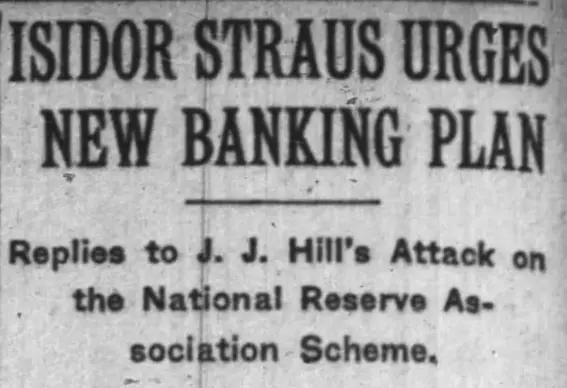
A headline in The New York Times, Monday 16 October 1911, page 10, reveals that Straus actually supported the forming of a federal reserve bank.
(Click image to read full article)
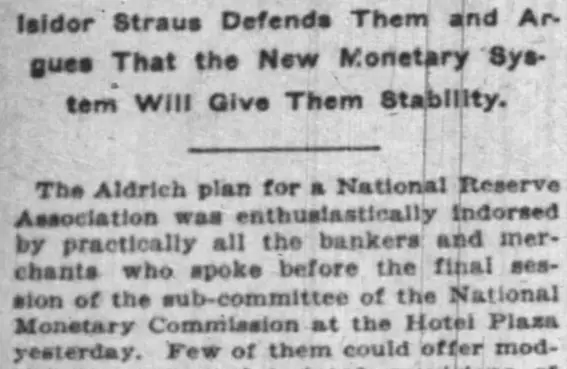
Just a few days later, another headline in The New York Times, Wednesday 18 October 1911, page 14, reveals that Straus defended the forming of a federal reserve bank.
(Click image to read full article)
Perhaps their position is also irrelevant, according to Dailydot.com: "The three living would have done nothing to stop the bank from being launched, as the Federal Reserve Act easily passed both houses of Congress in 1913, and the U.S. had already attempted a central banking system several times previously. Beyond that, sources of the time have Guggenheim booking his spot on the ship after Morgan cancelled [sic], meaning the conspiracy very nearly wouldn’t have worked in the first place." (Link to Dailydot article)
Skeptoid also says it would have been too late to make a difference: "Mustering support for the Federal Reserve had taken decades; it had first become clear that the US needed central banking during the Revolutionary War in the 1700s. Sinking three nabobs a mere two years before the plan was finally concluded would have been far too little far too late to make any difference." (Link to Skeptoid article)
3. No explanation for how Morgan would have orchestrated the sinking and ensured their deaths
The website Dailydot.com notes:"There’s also no indication in the conspiracy theory of how Morgan would have ensured the ship sinks. Did he order the crew to hit an iceberg? Why would they take his orders, knowing they weren’t prepared for the catastrophe to come? What if the ship had survived?" (Link to Dailydot article)
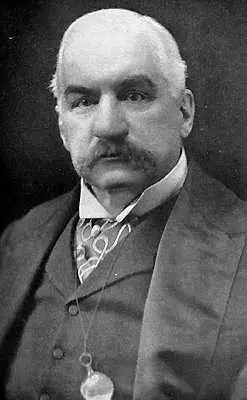
John Pierpont Morgan
According to The Washington Post, "the plot supposedly involved ensuring the ship had the wrong signal flares. In a sci-fi-horror twist, believers also claim the Titanic’s decks could be electromagnetically sealed to trap passengers." ("Fact-checking QAnon conspiracy theories: Did J.P. Morgan sink the Titanic?" August 4, 2018 by Erick Trickey Link to article)
“Some of the ‘facts’ offered up in the retellings of this tale are absolutely hysterical to read, at least to anyone familiar with the historical facts,” wrote maritime historian J. Kent Layton in his 2016 book “Conspiracies at Sea: Titanic and Lusitania.” He adds that it's almost unimaginable that Morgan could have gotten all three of his major rivals to take the fateful trip. "Surely there had to be easier ways to carry out the plan?"
Even more pointedly, how could Morgan ensure that Astor, Guggenheim and Straus all definitely died in the disaster? As survival depended very much on which side of Titanic you departed: Second officer Lightoller on the port side refused any men (and even stewardesses) entry as he interpreted his order as "women and children ONLY". However on the starboard side First officer Murdoch interpreted it as "women and children FIRST" so some wealthy and influential men such as Sir Cosmo Duff-Gordon escaped in lifeboat no.1, Karl Behr, American tennis star and banker in lifeboat no.5 and Bruce Ismay in collapsible C, all launched from the starboard side.
Historian and author J. Kent Layton (Conspiracies at Sea: Titanic and Lusitania, and On a Sea of Glass: The Life & Loss of the RMS Titanic) has pointed out that "if the sinking had actually been a conspiracy to kill those three individuals, there would have been no way that they could ensure their actual demise unless they had locked them somewhere inside the ship to die as it sank. Instead, the evidence indicates that all three were seen during the sinking," Layton said. In an Irish Star article dated 21 February 2024, he noted:
"Guggenheim famously cast aside his heavy coat and lifebelt after his steward had helped him into them, saying that he and his manservant were 'dressed in their best and prepared to go down as gentlemen'. Straus nearly made it into a lifeboat, and fellow passengers even recommended that he board a lifeboat with his wife, but he deferred, preferring to let women and children board while he waited behind with other men.
Astor was seen very late in the disaster, helping his wife into a lifeboat; when he asked an officer loading the boat, apparently Second Officer Lightoller, if he could board, Lightoller said no. However, Lightoller had maintained a rather rigid policy of allowing no men into the lifeboats that he filled, and there had been plenty of other opportunities for Astor to board a boat. In fact, we recently discovered an account that indicated that Astor and his wife had approached an early boat on the other side of the ship, when the situation seemed less serious, but that they had stepped back from the lifeboat of their own accord at the last moment and stayed for a while longer on the ship.
If a conspiracy to kill these three men had been so deep and involved so as to actually sink an ocean liner and kill hundreds of innocent people, one would think that the individuals responsible would not have left the survival of these three men to chance."
4. Mathematically it would be exposed by now
Maritime historian J. Kent Layton in his 2016 book Conspiracies at Sea: Titanic and Lusitania notes: "Even more importantly: how was it that no one came forward in the century since and said, 'Yes, I helped to set up the sinking of the Titanic in order to kill three men who were opposed to the formation of the US Federal Reserve'?"
Interestingly, according to a theory by Dr David Grimes, from Oxford University, there is an equation that expresses 'how long alleged conspiracies could "survive" before being revealed - deliberately or unwittingly - to the public at large'. This equation relies upon three factors: the number of conspirators involved, the amount of time that has passed, and the intrinsic probability of a conspiracy failing. Based on this equation, this Federal Reserve conspiracy would undoubtedly have been fully revealed as true by now. Read the BBC article on this here. The full Plos One journal can be read here. (Published: January 26, 2016)
5. J.P Morgan's cancellation falsely portrayed
According to the Pittsburgh Post-Gazette "some biographers indicate that Morgan never planned to sail on Titanic's maiden voyage because of his distaste 'for photographers and reporters who would swarm aboard at Southampton'" (Melanie Linn Gutowski, Pittsburgh Post-Gazette, April 16, 2012 Link to article)
In regard to J.P. Morgan cancelling "at the last minute" research by Mark Baber and posted on Encyclopaedia Titanica actually reveals it to be an urban myth. Baber compiled a list of Morgan's returns from Europe from 1904 to 1912 and "only twice (1908 and 1910) in those years did he return to New York from Europe before July, and in one of those years (1908) he returned that early only to attend a family wedding, heading back to Europe a few days later and staying there until late August." And those occasions he returned early were in June -never as early as April. Even more conclusively, a New York Times newspaper article of Thursday 28th March 1912 reveals that in March "J. Pierpont Morgan has written a cordial letter to the committee, announcing that he will be in Venice on April 23 for the inauguration of the biennial International Art Exhibition, April 25, and dedicate the new Campanile of St. Mark's." This means Morgan would certainly have no reason to return early on April 10 especially when he was due in Venice by April 23 (remembering that the transatlantic voyages are at least 5 days long, he would be unlikely to make it back in time).
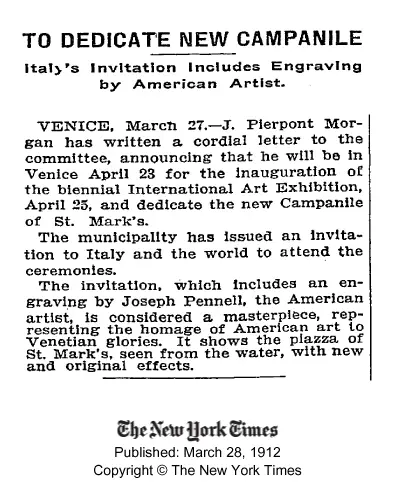
This New York Times newspaper article, printed prior to Titanic's departure, shows conclusively that Morgan would be in Venice on April 23 so he would be in no position to take the Titanic back to the United States and return in time.
The Pittsburgh Post-Gazette goes further, giving a clear reason for his abscense:
"It is certain that he attended the launch in Belfast of Titanic in 1911 in his capacity as head of the IMM. Whether Morgan intended to sail aboard the ship or not, he was saved from a watery fate when the business of his art collection delayed him in Britain. Morgan had been abroad overseeing the moving of his vast collections of fine and decorative arts from Britain, where he had been storing them for tax reasons, to the United States. Morgan stayed behind when he was given the opportunity to view and purchase a rare set of medieval tapestries outside Chartres, France. He telegraphed, 'Business will deny me the pleasure of being one of the first to cross on the finest vessel of the IMM.'" (Melanie Linn Gutowski, Pittsburgh Post-Gazette, April 16, 2012 Link to article)
Erick Trickey of The Washington Post also has further information on this:
"Morgan’s actual reason for not sailing on the Titanic’s maiden voyage is well-documented. According to Jean Strouse’s 1999 biography “Morgan: American Financier” and Brad Matsen’s 2008 book “Titanic’s Last Secrets,” Morgan was busy trying to ship his vast art collection in England and France by sea to New York’s Metropolitan Museum of Art. In late March, he hit a setback: a U.S. Customs Office art specialist, sent to London to inspect the shipments, unexpectedly left for the States. Morgan stopped the shipments, asked the art dealer supervising them to meet him in France in mid-April, and sent a telegram to the White Star Line’s president with his regrets: Business would keep him from sailing on the Titanic." ("Fact-checking QAnon conspiracy theories: Did J.P. Morgan sink the Titanic?" August 4, 2018 by Erick Trickey Link to article)
Additionally, "shortly after the news of Titanic's sinking broke, J.P. Morgan wired a friend, '.. greatly upset by loss Titanic -- my heart ... very heavy.' " (Melanie Linn Gutowski, Pittsburgh Post-Gazette, April 16, 2012 Link to article.)
J.P. Morgan's health was declining and he later died on March 31st, 1913, before he could see the establishment of the Federal Reserve.
Further Reading:
Reuters Fact Check: "CORRECTED-Fact Check-J.P. Morgan did not sink the Titanic to push forward plans for the U.S. Federal Reserve"
https://www.reuters.com/article/factcheck-titanic-conspiracy-idUSL1N2LF18G/
Also:
https://www.investopedia.com/articles/economics/08/federalreserve.asp
https://titanichistoricalsociety.org/international-mercantile-marine-company/
https://rmstitanichotel.co.uk/blog/j-p-morgan-the-man-behind-morgans-spa/
https://www.history.com/news/titanic-sinking-conspiracy-myths-jp-morgan-olympic
https://www.businessinsider.com/titanic-sinking-conspiracy-theories-2018-4?r=US&IR=T